If your RV’s roof has seen better days, you’re probably looking for a way to make it look like new again. With the right RV roof covers, you can easily breathe new life into your recreational vehicle and keep it in pristine condition for years to come. The best part is that these roof covers are stylish, affordable, and easy to install – perfect for any budget or amateur DIY-er. So, don’t waste any more time – check out these must-have RV roof cover ideas today and watch your RV transform before your very eyes!
Table of Contents
What is an RV Roof Cover and why do you need it?
An RV Roof Cover is an accessory designed to protect your recreational vehicle’s roof from the elements. It can provide extra security against hail, snow, and other inclement weather conditions that could damage your RV’s roof over time. An RV Roof Cover can also help block out UV rays that could cause fading or discoloration of the surface of your roof over time.
Finally, an RV Roof Cover can also add a layer of aesthetic appeal to your vehicle by allowing you to choose from various colors and styles that can help enhance its overall look. No matter what type of recreational vehicle you own, having a roof cover in place is essential for keeping it safe and secure while you are out on the road [1].
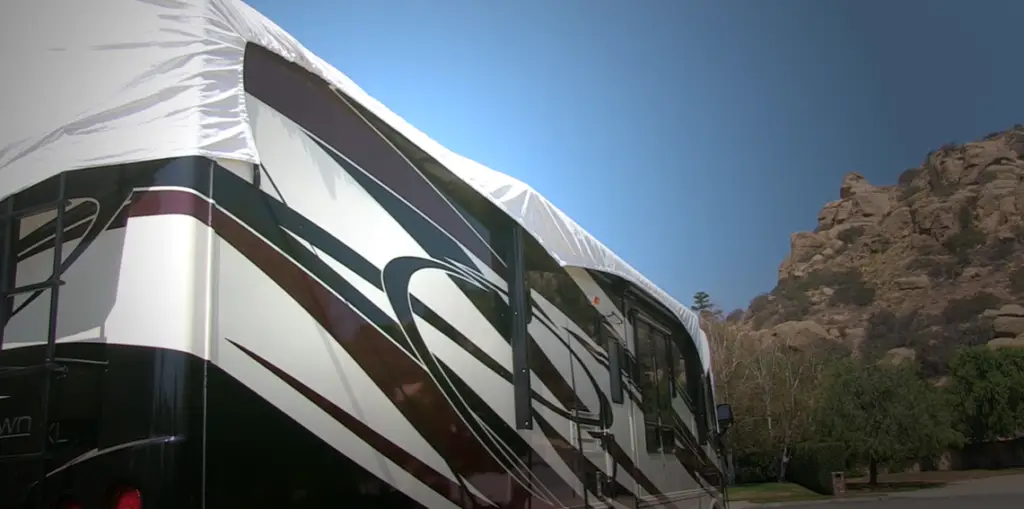
How to Choose the Best RV Shelter
Location
When selecting a suitable RV shelter, the most important factor to consider is location. You need to ensure that the shelter is in an area that meets your criteria for safety and convenience. The best RV shelters are often located near recreational areas such as parks, lakes, rivers, and beaches. They should also be close enough to nearby amenities like groceries and gas stations for easy access during your travels.
Size and Features
Another crucial factor when choosing the perfect RV shelter is size and features. Be sure to select one that will meet all of your needs without being too large or too small. Some shelters come with extra features like awnings, outdoor kitchens, sunscreens, shaded areas, etc., which can help make your stay more enjoyable. Additionally, look into the types of materials used to construct the shelter and its insulation capability so you can be sure it will protect against inclement weather.
Intended Use
You should consider the intended use for your RV shelter. Are you looking for a place to stay during long family trips or will it be used as additional storage space? Depending on what your needs are, you may require a more permanent structure or one that can easily be relocated when necessary. Once you have determined what type of shelter would best suit your needs, then you can start shopping around and looking at different options.
Budget
Lastly, when searching for an RV shelter, consider your budget. Be sure that the shelter is within your price range and meets all of your needs. It’s also important to check out any additional fees or costs associated with the rental agreement such as maintenance fees or security deposits. By doing this, you’ll be able to find a reliable place to park your RV without breaking the bank [2].
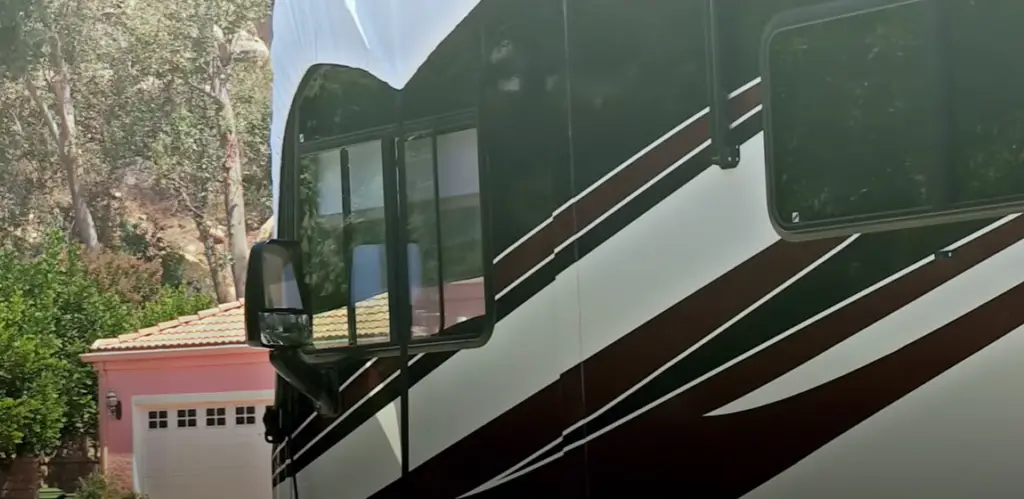
Top 14 RV Roof Cover Ideas
An RV Roof Cover Attach to a Pergola
A pergola roof can give your RV a unique look and offer plenty of shade. The cover attaches to the metal framework with either eye bolts or zip ties, depending on the design. You can choose from a variety of materials, such as steel, aluminum, canvas, or weather-resistant fabric. You may even opt to hang outdoor curtains for extra style and privacy.
Aluminum Patio Covers
These are often found in DIY kits that you assemble yourself. The aluminum material is very durable and will withstand rain and other extreme weather conditions. It also provides excellent ventilation so your RV stays cool during hot summer days. Plus, adding one of these covers will increase the overall value of your vehicle by providing additional storage space.
Fiberglass Patio Covers
These are similar to aluminum patio covers, but they are made of more durable fiberglass material. The installation is often quicker and easier than other types of RV roof covers because it has fewer parts and requires less maintenance. Plus, the fiberglass material provides superior protection against inclement weather conditions.
Canvas Awning Cover
This type of cover is very popular for RVs since it’s easy to install and lightweight. It also helps block out UV rays while keeping your RV cool during the summer months. You can choose from several different colors and patterns so you can customize the look of your vehicle without having to replace the entire roof structure.
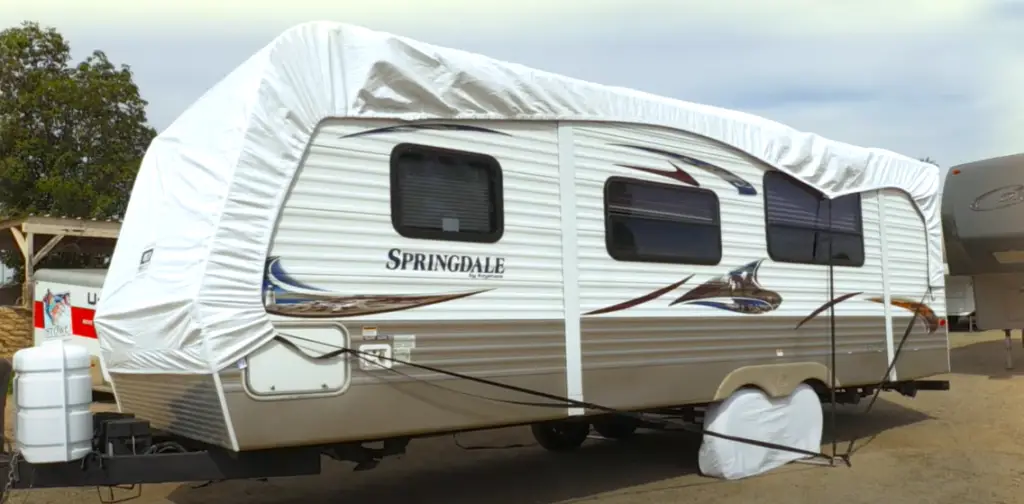
Front Deck RV Storage Cover
If you need extra storage space for your RV, then a front deck RV storage cover can be the perfect solution. It attaches securely to your vehicle’s roof and features plenty of room for items such as bikes, kayaks, or other outdoor equipment. The cover is also waterproof so it will keep your belongings safe from the elements.
Retractable Awning Cover
This type of RV roof cover offers both shade and protection from inclement weather. The retractable fabric is made with strong woven polyester that blocks out UV rays and rain. Plus, it has an easy-to-use mechanism that allows you to open and close the awning quickly when needed.
Fabric/Steel Frame Tent
This type of RV roof cover is ideal if you need something that’s lightweight and easy to install. The material used for the roof is a combination of fabric and steel, which provides extra protection from the sun and rain. Plus, it has plenty of room for storage underneath so you can keep items like tools or spare parts nearby.
EPDM Rubber Roof Cover
If you want an RV roof cover that offers superior protection against UV rays, then EPDM rubber is your best bet. This durable material won’t fade or tear easily and also reflects heat away from your vehicle – making it perfect for hot summer days. It also requires minimal maintenance and can be easily cut to fit any size vehicle.
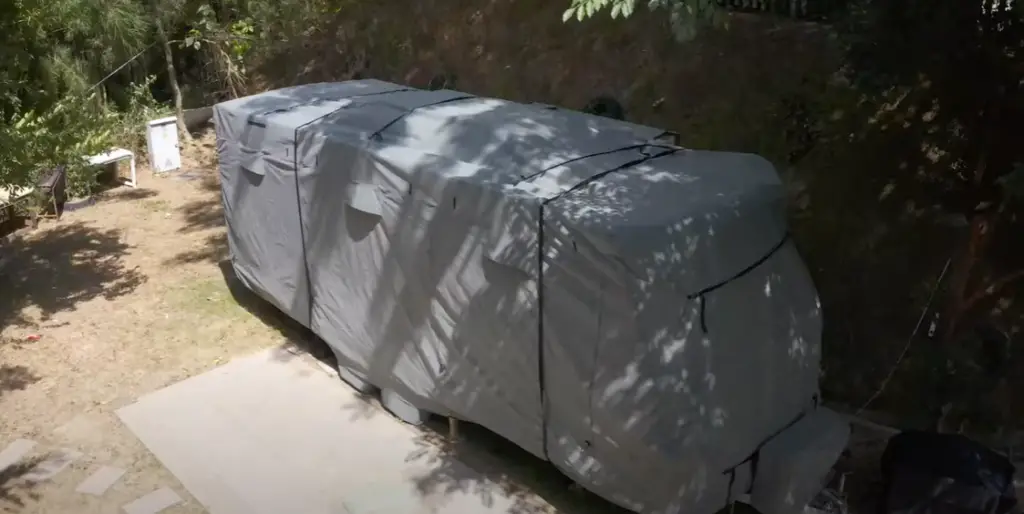
A Story Building Shade Cover For an RV
If you want to add a unique style to your RV, then a story-building shade cover could be the perfect option for you. This type of cover is made with aluminum and fabric, which allows it to offer plenty of shade while creating an interesting look. Plus, it’s easy to install and requires minimal maintenance over time.
3-in-1 RV Shade Roof Cover
The 3-in-1 RV shade roof cover offers plenty of protection from the sun and other elements. It features three layers of fabric that provide additional insulation while reflecting away heat. Plus, you can adjust the tension on each layer for added comfort and convenience.
House And RV Roof Shade Cover
If you don’t have a lot of space for a large cover, then this option is ideal. It features both RV and house roof shade covers that can be combined to create the perfect look. The material used is a weather-resistant fabric that won’t fade easily and also offers plenty of protection from the sun and rain. Plus, it’s lightweight and easy to install so you can get started right away.
Roof Cover Shade Deck Under a Tree
This type of cover is great for anyone who wants to take advantage of a nearby tree for extra shade. It features a durable fabric that won’t tear easily and also provides plenty of protection from UV rays. Plus, you can add outdoor curtains or other accessories to create the perfect look for your RV.
Pergola Roof Shade Cover
A pergola roof shade cover is the perfect way to add a little extra style to your RV. This type of cover attaches directly to the metal framework and features a variety of materials such as steel, aluminum, canvas, or weather-resistant fabric. Plus, you can even hang outdoor curtains for extra privacy or decoration.
Slope Roof Cover Shade
The slope roof cover shade is perfect for anyone looking to add some style and protection from the sun. It features a durable fabric that offers plenty of UV protection while also reflecting heat away from your vehicle. Plus, this type of cover can easily be adjusted so you always get the perfect amount of shade [3].
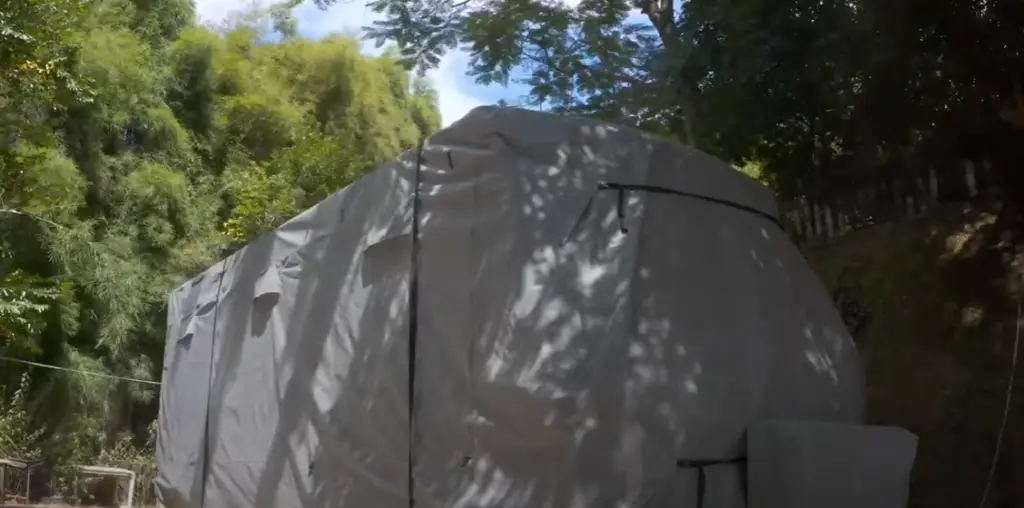
How to maintain an RV Roof cover?
- Remove dirt and debris from the roof: Make sure you use a soft brush to remove any dirt, leaves, or other debris that may have accumulated on your RV’s roof cover. This will help keep the surface of the cover free from abrasive materials that can cause damage over time.
- Inspect for tears or holes: It’s important to check your RV’s roof cover periodically for signs of wear and tear such as torn material, cracks in seams, punctures, etc. If you find any damage, it may need to be repaired before more serious issues arise.
- Clean the roof using a mild cleaner: Use a mild soap (preferably something specifically designed for RVs) and a soft cloth to gently scrub away dirt and grime. Rinse the roof off with clean water afterward to ensure that all residue has been removed.
- Apply a waterproof sealant: Applying a sealant is an important step in maintaining your RV’s roof cover, as it helps protect against leaks and other damage caused by weather exposure. Use a brush or roller to apply an even layer of sealant over the entire surface area of the roof. Allow it to dry completely before putting any weight back on the roof.
- Check the seals around vents and windows: Over time, seals around vents and windows can become brittle or worn out due to constant exposure to sun, rain, wind, etc. Inspect the seals periodically and replace them if necessary to ensure that your RV is watertight.
- Perform regular maintenance checks: Make sure you check your RV’s roof cover for signs of damage or wear regularly. This will help catch any potential problems before they become too serious and require expensive repairs.
Follow these simple steps to keep your RV’s roof cover in top condition! Not only will it protect against leaks and other damage, but it can also extend the life of your vehicle significantly. With proper maintenance, your RV’s roof cover should last for many years to come! Congratulations on taking care of your RV’s roof cover!
How to use an RV Roof cover properly?
To use an RV roof cover properly, you should follow these simple but important steps:
- Measure your RV roof before purchasing an RV roof cover to ensure the correct size for a proper fit.
- Make sure that the area where you plan to install the RV roof cover is clean and free of debris. Remove any foreign objects from the surface of the RV, such as tree branches or dirt, before proceeding with the installation.
- Read and follow all instructions included in your RV roof cover package. Ensure that you have all the necessary tools and supplies on hand before beginning installation.
- Place one end of the RV roof cover over the side edge of your RV’s roof and begin unrolling it across until fully covers your entire vehicle’s rooftop.
- Secure the RV roof cover in place using the included ties or straps to ensure that it stays securely attached and doesn’t blow away in strong winds.
- Inspect your RV roof cover periodically for signs of wear and tear, such as fraying fabric or loose ties, and replace it if necessary.
Following these steps will help you get the most out of your RV roof cover while keeping your vehicle safe from the elements.
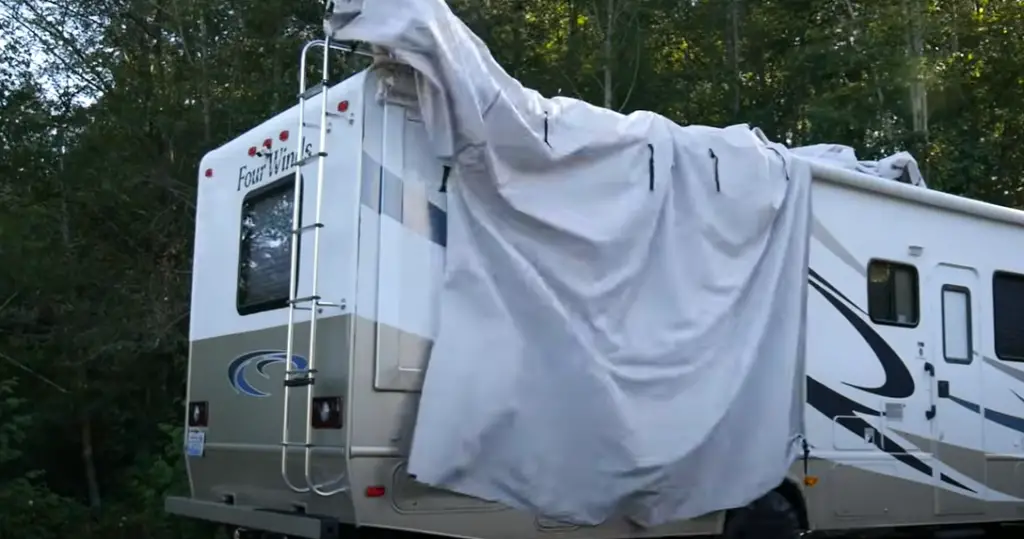
FAQ
What is the best way to protect an RV roof?
The best way to protect an RV roof is to use an RV roof coating. These coatings are designed to protect the roof from water damage, UV rays, and other environmental factors that can cause premature aging of the material. They also help prevent leaking and other common issues with RV roofs. Additionally, applying a protective layer of sealant or tape can further safeguard your investment and extend the life of its roof. Regular inspections should also be done on your RV’s roof to detect any small cracks or weak spots before they become bigger problems. Taking these steps will ensure that you get the most out of your recreational vehicle for many years!
What is the best material for an RV cover?
The best material for an RV cover is a heavy-duty, waterproof fabric that can withstand the elements. Polyester and vinyl are two popular materials used in RV covers because they have excellent UV protection properties and are water-resistant. If you live in a wet climate, consider getting a polyurethane or rubberized fabric to further protect your RV from moisture damage. Additionally, some fabrics come with special anti-mold and mildew coatings that help keep mold and mildew from forming on the surface of the cover. Lastly, look for an RV cover that has air pockets between its fibers to provide superior breathability and ventilation so that heat doesn’t build up underneath your vehicle while it’s covered.
What is the best way to clean an RV roof?
The best way to clean an RV roof is to use a mild, soap-based cleaner or detergent. Avoid using harsh chemicals as these can damage the material on your roof and make it prone to leaking. Start by brushing away any loose dirt or debris before rinsing the area with water. Once done, use a soft brush and soapy solution to scrub away any remaining dirt or grime. When finished, rinse off the solution thoroughly with cold water and let the surface dry naturally in the sun. Never pressure wash an RV roof as this can cause more damage than good! Alternatively, you could hire a professional cleaning service to take care of this task for you.
What is the best way to store an RV when not in use?
When not in use, the best way to store an RV is under a covered parking facility. This will protect it from harsh weather conditions like rain and snow, as well as help prevent sun damage. Additionally, keeping the RV away from direct sunlight also helps protect its interior finishes and upholstery from fading. If you don’t have access to a covered parking space, consider investing in a high-quality RV cover that can help keep your vehicle safe during periods of non-use. Finally, make sure to check on your RV periodically if it’s left outdoors for extended periods so you can detect any issues early on before they become worse.
What should I look for when buying an RV cover?
When buying an RV cover, look for one that is water-resistant and UV-protected. It should also be made from a durable material like polyester or vinyl and come with a breathable fabric so that heat doesn’t build up underneath it while in use. Additionally, some covers may have additional features like anti-mold and mildew coatings as well as air pockets between their fibers to provide superior ventilation. Lastly, make sure the cover fits your specific RV model properly for the best results.
How tall does an RV carport need to be?
The height of an RV carport should be at least 12 feet tall. This will ensure that the roof has enough clearance to fit your recreational vehicle and any other tall items you may need to store underneath it. Additionally, this height also allows for easier access when entering and exiting the carport. When considering the height of an RV carport, always make sure to check with local building codes before beginning construction!
Are RV carports worth it?
RV carports are definitely worth considering if you’re looking for a way to protect your recreational vehicle from the elements. Not only do they provide superior protection against rain, snow, and UV rays, but they also help keep your RV cool in hot weather by providing shade and ventilation. Additionally, carports are relatively inexpensive compared to other options like fully enclosed garages or metal sheds. Ultimately, investing in an RV carport can be a great way to ensure that your recreational vehicle is safe and secure when not in use.
Can I build an RV carport myself?
Building an RV carport yourself is certainly possible, but it’s important to make sure you understand the process before proceeding. You will need to have basic carpentry and construction knowledge as well as acquire the necessary building materials from a local home improvement store or online retailer. Additionally, you should also research local building codes and ordinances in your area to ensure that your carport abides by them. All of these steps should be taken with caution and care if you decide to build an RV carport on your own!
What else can I use my RV carport for?
An RV carport can be used for a variety of purposes beyond just storing recreational vehicles. It can also be used as a makeshift garage or workshop for doing DIY projects, as a shelter for outdoor events and gatherings, or even as a place to park boats and ATVs. Additionally, some people also use RV carports as covered patios or decks where they can relax and enjoy the outdoors without having to worry about rain or sun damage. Ultimately, an RV carport can be a great asset if you’re looking for a versatile structure that can serve multiple purposes!
How to choose the best RV cover?
When choosing the best RV cover, look for one that is made from a durable material such as polyester or vinyl, and has excellent UV protection properties. Additionally, you should also consider getting a waterproof fabric to further protect your RV from moisture damage. Some fabrics come with special anti-mold and mildew coatings that help keep mold and mildew from forming on the surface of the cover. Lastly, look for an RV cover that has air pockets between its fibers to provide superior breathability and ventilation so that heat doesn’t build up underneath your vehicle while it’s covered.
Why not cover an RV with a tarp?
RV covers are specifically designed to provide superior protection for recreational vehicles, whereas tarps are not. Tarps may seem like a more cost-effective option in the short term, but they don’t offer the same level of protection as RV covers do. Additionally, since tarps aren’t designed to be used outdoors for long periods, they can become easily damaged by wind and rain. Finally, even if you use reinforced grommets and tie-downs to secure a tarp over your RV, it’s still likely to blow away or start collecting mold and mildew due to its lack of breathability.
Useful Video: How to Build a Travel Trailer – DIY Guide to Installing the Floor and Framing
Conclusion Paragraph
If you are a happy owner of an RV, you should surely know how to protect it from harsh weather conditions. Different RV roof covers can be used to protect the interior from rain, snow, and other damaging weather elements. Furthermore, inspecting your RV roof regularly is necessary to ensure that it does not suffer any damage from long-term exposure. Knowing how to properly care for your RV roof will go a long way in ensuring your vehicle stays operational for years to come. A few simple steps of proper maintenance and protection can save you from expensive repairs and keep your RV running smoothly. With this knowledge in hand, you’ll be able to enjoy more happy travels in the future!
References:
- https://www.myteeproducts.com/blog/why-you-should-consider-covering-your-rv-or-travel-trailer/
- https://www.cardinalcarports.com/blog/entry/how-to-choose-the-right-rv-shelter-for-your-motorhome
- https://commutter.com/top-10-rv-roof-cover-ideas/

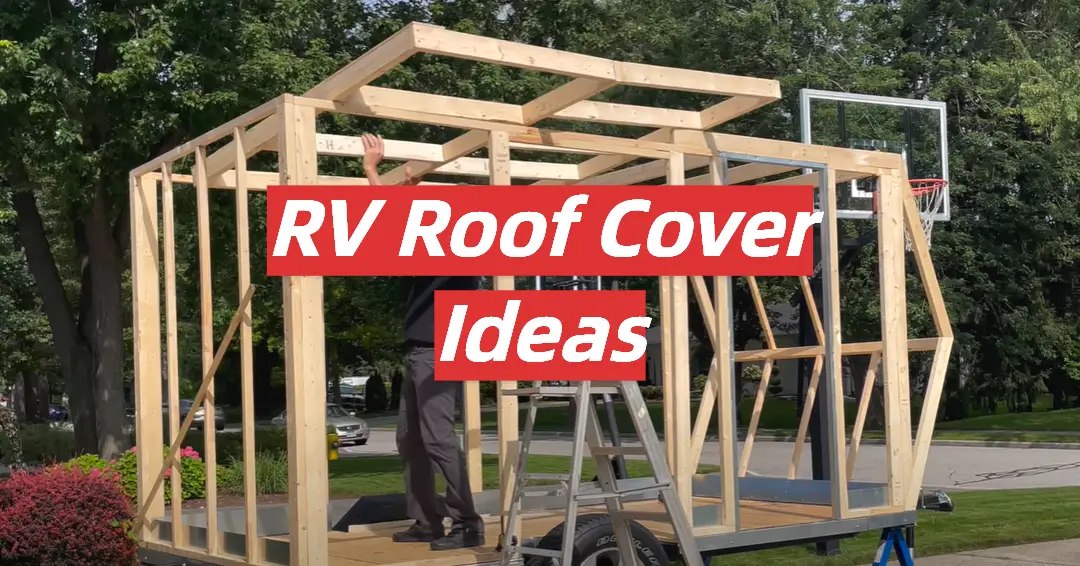




Leave a Reply